Evaluating Inequity in Access to Park-Based Physical Activity at the Sub-District Scale: A Case Study in Xianyang, China
Abstract
1. Introduction
2. Materials and Methods
2.1. Study Area
2.2. Construction of Comprehensive Evaluation Scores
2.2.1. Park-Based Physical Activity Composite Attractiveness Score
2.2.2. Park Supply Index and Park Demand Index at Sub-District Scale
2.3. Procedures for Evaluating Urban Park Service Based on PA Support
2.3.1. Data Acquisition
2.3.2. Data Normalization
2.3.3. Gini Coefficient and Location Quotient of Urban Park Services
2.3.4. Optimization of Urban Park Service Based on PCAS
3. Results
3.1. Results of PCAS
- (1)
- The composite attractiveness score for the 13 parks was 46 (SD = 18, range = 12–69). Except for Tongyi Square (69), Liangsidu Park (69), Weibin Park (62), and Binhe Wetland Park (61), the remaining 69% of parks scored below the qualified benchmark 60. Among the scores of each dimension, park area and park accessibility were 48 (SD = 32, range = 5–100) and 52 (SD = 36, range = 5–100) with 69% and 62% below 60. Park sports facilities’ score was 38 (SD = 16, range = 5–63) with 92% below 60 (Figure 5a).
- (2)
- The Five Rings Sports Park had the highest score but only 63 park facilities. The average scores for the index of park sports facilities were sports fields (56), multi-functional squares (56), national fitness stations (53), children’s physical activity fields (12), and children’s amusement areas (8). Figure 5b shows 77% and 92% of the parks lacked areas for children’s physical activity fields and amusement areas.
3.2. Scores of PSI and PDI at Sub-District Scales
- (1)
- The average PSI score of the 14 sub-districts was 42 (SD = 20, range = 0–64). The 14 sub-districts showed a spatial distribution characterized by a zonal distribution along both sides of the Weihe River, decreasing from south to north (Figure 6). Using this distribution, we formed the scores into three sub-district grades. The first included XLL (58), RML (64), and WB (63). The second was WYXL (47), CYZ (51), and ZS (54); all adjacent to the Weihe River distribution. The lowest grade was WJB and GD in the north, which were not covered by the park service area.
- (2)
- The average scores of the 14 sub-districts were 36, 45, and 31, respectively, for the area, accessibility, and sports facilities. The WB, XL, and RM sub-districts all received higher scores for supply area and sports facilities. The WY and WHL sub-districts received lower scores in these two dimensions but the highest score in supply accessibility (Figure 6).
- (3)
- The average PDI score was 49, showing a decreasing demand score due to the later sub-district establishment. For example, the PDI score of XX (founded in 1949) was 88, higher than MQ (PDI = 23, founded in 2007). The average demand score of the old urban area was 61, that of the GD sub-district was 48, and that of the CYZ sub-district was 20; lower than the other sub-districts established in the same period. The average demand score of the new urban area was 21, indicating that sub-district DT was higher than the other sub-districts established in the same period with a score of 42 (Figure 7).
3.3. Equity of Urban Parks Service Level
3.4. Optimization of Urban Park Services Based on PCAS
- (1)
- Adding New Parks to Increase Service Area
- (2)
- Improving Park Accessibility Using Scenario I
- (3)
- Increasing Park Sports Facilities Using Scenario I
4. Discussion
4.1. Evaluating the Inequity of PCAS at the Sub-District Scale in Xianyang
4.2. Suggestions for Urban Park Planning and Policy
4.3. The Applicability of the PCAS
4.4. Limitations and Prospects
5. Conclusions
Author Contributions
Funding
Data Availability Statement
Conflicts of Interest
Appendix A
| Park Name | Sports Field/m2 | Walking Path/m2 | Square/m2 | Children’s Physical Activity Field/m2 | Children’s Playground/m2 | Site Diversity Index |
|---|---|---|---|---|---|---|
| Weibin Park | 772.75 | 65.00 | 7352.26 | 0.00 | 0.00 | 1.08 |
| Tongyi Square | 3339.16 | 2328.35 | 4294.16 | 394.40 | 0.00 | 1.07 |
| Liangsidu Park | 11,943.75 | 1304.08 | 10,751.24 | 0.00 | 0.00 | 1.09 |
| Five Ring Sports Park | 31,769.74 | 2681.10 | 9001.90 | 0.00 | 0.00 | 1.21 |
| Silu Park | 0.00 | 0.00 | 11,205.47 | 861.65 | 0.00 | 1.13 |
| Baimahe Park | 0.00 | 0.00 | 3717.15 | 0.00 | 0.00 | 1.25 |
| Fengxi New City Central Green Corridor | 399.47 | 45.00 | 1791.96 | 1228.23 | 0.00 | 1.02 |
| Fenghe Forest Park | 0.00 | 95.11 | 704.62 | 0.00 | 0.00 | 1.01 |
| Qindu Cultural Park | 1223.28 | 296.38 | 2864.17 | 0.00 | 0.00 | 1.10 |
| Binhe Wetland Park | 6634.79 | 1382.37 | 9817.13 | 0.00 | 0.00 | 1.11 |
| Nanyuan Park | 404.39 | 2161.49 | 4983.17 | 0.00 | 0.00 | 1.06 |
| Gudu Park | 288.94 | 369.55 | 2560.06 | 0.00 | 870.97 | 1.17 |
| Gudu Heritage Park | 0.00 | 432.99 | 2923.25 | 0.00 | 0.00 | 1.06 |
| Mean (M) | 3905.11 | 858.57 | 5535.89 | 191.10 | 67.00 | 1.10 |
| Standard Deviation (SD) | 8628.05 | 950.20 | 3489.75 | 385.49 | 232.09 | 0.07 |
| City Name | Mean ± SD | |||
|---|---|---|---|---|
| Area Score | Accessibility Score | Sports Facilities Score | PCAS Scores | |
| Xi’an | 55.40 ± 18.15 | 33.57 ± 19.40 | 56.19 ± 30.40 | 48.39 ± 14.87 |
| Yangling | 53.00 ± 19.56 | 32.67 ± 16.69 | 60.00 ± 40.62 | 48.56 ± 14.38 |
References
- Ferreira, F.; Vasconcelos, L.; Ferreira, J.C. Socio-Ecological and Economic Evaluation of Urban Parks—A Methodology Integrating and Articulating Diverse Components. J. Outdoor Recreat. Tour. 2022, 40, 100512. [Google Scholar] [CrossRef]
- Ali, M.J.; Rahaman, A. Assessing the Potential of Urban Parks for Health-Promoting Physical Activity: Geospatial Tools in Planning for Healthy City Living in Kolkata. GeoJournal 2024, 89, 164. [Google Scholar] [CrossRef]
- Wang, P.; Han, L.; Hao, R.; Mei, R. Understanding the Relationship Between Small Urban Parks and Mental Health: A Case Study in Shanghai, China. Urban For. Urban Green. 2022, 78, 127784. [Google Scholar] [CrossRef]
- Blaszczy, M.; Suchocka, M.; Wojnowska-Heciak, M.; Muszynska, M. Quality of Urban Parks in the Perception of City Residents with Mobility Difficulties. PeerJ 2020, 8, e10570. [Google Scholar] [CrossRef] [PubMed]
- Zhang, R.; Peng, S.; Sun, F.; Deng, L.; Che, Y. Assessing the Social Equity of Urban Parks: An Improved Index Integrating Multiple Quality Dimensions and Service Accessibility. Cities 2022, 129, 103839. [Google Scholar] [CrossRef]
- Edwards, N.; Hooper, P. The Park Physical Activity Questionnaire (Park-PAQ): A Reliable Measurement Tool for Park-Based and Total Physical Activity. Health Place 2023, 83, 103085. [Google Scholar] [CrossRef]
- Jáuregui, A.; Lambert, E.V.; Panter, J.; Moore, C.; Salvo, D. Scaling up Urban Infrastructure for Physical Activity in the COVID-19 Pandemic and Beyond. Lancet 2021, 398, 370–372. [Google Scholar] [CrossRef] [PubMed]
- Lancet, T. A Sporting Chance: Physical Activity as Part of Everyday Life. Lancet 2021, 398, 365. [Google Scholar] [CrossRef] [PubMed]
- Dong, J.; Wang, Y.; Yang, Y.; Luo, X.; Wang, L. A Multi-Level Framework for Assessing the Spatial Equity of Urban Public Space towards SDG 11.7.1—A Case Study in Beijing. Appl. Geogr. 2023, 161, 103142. [Google Scholar] [CrossRef]
- Cheng, Y.; Zhang, J.; Wei, W.; Zhao, B. Effects of Urban Parks on Residents’ Expressed Happiness before and during the COVID-19 Pandemic. Landsc. Urban Plan. 2021, 212, 104118. [Google Scholar] [CrossRef] [PubMed]
- Deng, L.; Li, X.; Luo, H.; Fu, E.-K.; Ma, J.; Sun, L.-X.; Huang, Z.; Cai, S.-Z.; Jia, Y. Empirical Study of Landscape Types, Landscape Elements and Landscape Components of the Urban Park Promoting Physiological and Psychological Restoration. Urban For. Urban Green. 2020, 48, 126488. [Google Scholar] [CrossRef]
- Zhao, Y.; Gong, P. Optimal Site Selection Strategies for Urban Parks Green Spaces under the Joint Perspective of Spatial Equity and Social Equity. Front. Public Health 2024, 12, 1310340. [Google Scholar] [CrossRef]
- Wang, L.; Zhou, J.; Wang, P.; Pan, C.; Li, H. Green Gentrification and Urban Parks: Exploring the Complex Dynamics of Commercial Transformation. J. Knowl. Econ. 2024. [Google Scholar] [CrossRef]
- Bhor, N.; Mayavel, D. The Socio-Spatial Distribution and Equity of Access to Urban Parks: A Case Study of Bengaluru, India. Challenges 2024, 15, 20. [Google Scholar] [CrossRef]
- Fan, P.; Xu, L.; Yue, W.; Chen, J. Accessibility of Public Urban Green Space in an Urban Periphery: The Case of Shanghai. Landsc. Urban Plan. 2017, 165, 177–192. [Google Scholar] [CrossRef]
- Wang, C.; Wang, S.; Cao, Y.; Yan, H.; Li, Y. The Social Equity of Urban Parks in High-Density Urban Areas: A Case Study in the Core Area of Beijing. Sustainability 2023, 15, 13849. [Google Scholar] [CrossRef]
- Yu, S.Q.; Zhu, X.G.; Liu, F.B.; Sun, J.; Wu, Y. The Evaluation of Accessibilities to Urban Parks from the Perspective of Social Justice: A Case Study of Nanjing. Mod. Urban Res. 2020, 35, 18–25. (In Chinese) [Google Scholar]
- National Data of China. Available online: https://data.stats.gov.cn/easyquery.htm?cn=E0103 (accessed on 14 August 2024).
- Farkas, J.Z.; Kovacs, Z.; Csomos, G. The Availability of Green Spaces for Different Socio-Economic Groups in Cities: A Case Study of Budapest, Hungary. J. Maps 2022, 18, 97–105. [Google Scholar] [CrossRef]
- Wang, Y.; Chang, Q. The Role of Urban Parks in Affecting Health Outcomes and the Differences Between Vulnerable Groups: Evidence from the Central City of Beijing. Urban For. Urban Green. 2023, 89, 128110. [Google Scholar] [CrossRef]
- Kaczynski, A.T.; Potwarka, L.R.; Saelens, B.E. Association of Park Size, Distance, and Features With Physical Activity in Neighborhood Parks. Am. J. Public Health 2008, 98, 1451–1456. [Google Scholar] [CrossRef] [PubMed]
- Yu, S.Q.; Zhu, X.G.; Sun, J.; He, Q.; Zhou, J.Y. The ParkScore System in USA and Its Inspirations. Chin. Landsc. Archit. 2020, 36, 103–108. (In Chinese) [Google Scholar] [CrossRef]
- Diao, Y.; Hu, W.; He, B.-J. Analysis of the Impact of Park Scale on Urban Park Equity Based on 21 Incremental Scenarios in the Urban Core Area of Chongqing, China. Adv. Sustain. Syst. 2021, 5, 2100171. [Google Scholar] [CrossRef]
- Liu, R.; Xiao, J. Factors Affecting Users’ Satisfaction with Urban Parks Through Online Comments Data: Evidence from Shenzhen, China. Int. J. Environ. Res. Public Health 2021, 18, 253. [Google Scholar] [CrossRef] [PubMed]
- The 2023 Urban Construction Statistical Yearbook. Available online: https://www.mohurd.gov.cn/gongkai/fdzdgknr/sjfb/index.html (accessed on 10 November 2024).
- Xianyang City 2023 National Economic and Social Development Statistical Bulletin. Available online: https://tjj.xianyang.gov.cn/tjgz/tjxx/202404/t20240418_1757459.html (accessed on 10 November 2024).
- Xianyang City Master Plan (2011–2030). Available online: https://www.xianyang.gov.cn/zfxxgk/fdzdgknr/ghxx/201802/t20180228_516463.html (accessed on 10 November 2024).
- CJJ/T85-2017; People’s Republic of China Standard for Classification of Urban Green Space. Ministry of Housing and Urban-Rural Development of the People’s Republic of China: Beijing, China, 2017. Available online: https://www.mohurd.gov.cn/gongkai/zc/wjk/art/2018/art_17339_236545.html (accessed on 10 November 2024).
- Joseph, R.P.; Maddock, J.E. Comparative Analysis of Five Observational Audit Tools to Assess the Physical Environment of Parks for Physical Activity, 2016. Prev. Chronic Dis. 2016, 13, E166. [Google Scholar] [CrossRef] [PubMed]
- Yang, L. Research on the Evaluation Method and Application of Urban Park Equity Performance from the Perspective of Spatial Justice. Ph.D. Thesis, Chongqing University, Chongqing, China, 2022. (In Chinese). [Google Scholar]
- Chen, S.; Christensen, K.M.; Li, S. A Comparison of Park Access with Park Need for Children: A Case Study in Cache County, Utah. Landsc. Urban Plan. 2019, 187, 119–128. [Google Scholar] [CrossRef]
- Loukaitou-Sideris, A.; Stieglitz, O. Children in Los Angeles Parks: A Study of Equity, Quality and Children’s Satisfaction with Neighbourhood Parks. Town Plan. Rev. 2002, 73, 467–488. [Google Scholar] [CrossRef]
- Yuzhen, Z.; Jie, W.; Yang, C.; Jianping, Y. An Assessment of Urban Parks Distribution from Multiple Dimensions at the Community Level: A Case Study of Beijing. Environ. Impact Assess. Rev. 2021, 91, 106663. [Google Scholar] [CrossRef]
- Wang, S.; Wang, M.; Liu, Y. Access to Urban Parks: Comparing Spatial Accessibility Measures Using Three GIS-Based Approaches. Comput. Environ. Urban Syst. 2021, 90, 101713. [Google Scholar] [CrossRef]
- National Geomatics Center of China. Available online: https://www.webmap.cn/main.do?method=index (accessed on 2 September 2024).
- Lianjia Website Xianyang Residential Community Data. Available online: https://m.lianjia.com/xianyang/xiaoqu/ (accessed on 2 September 2024).
- The Seventh National Population Census Data. Available online: https://cnki.nbsti.net/CSYDMirror/trade/yearbook/Single/N2021100082?z=Z018 (accessed on 2 September 2024).
- Zheng, Q.Y.; Zhao, X.L.; Jin, M.X.; Liu, X.B. A Study on Diversity of Physical Activities in Urban Parks Based on POI Mixed-use: A Case Study of Futian District, Shenzhen. Planners 2020, 36, 78–86. (In Chinese) [Google Scholar]
- Feng, S.; Chen, L.; Sun, R.; Feng, Z.; Li, J.; Khan, M.S.; Jing, Y. The Distribution and Accessibility of Urban Parks in Beijing, China: Implications of Social Equity. Int. J. Environ. Res. Public Health 2019, 16, 4894. [Google Scholar] [CrossRef] [PubMed]
- Liu, W.-Y.; Huang, Y.-H.; Hsieh, C.-M. The Impacts of Different Climate Change Scenarios on Visits toward the National Forest Park in Taiwan. Forests 2020, 11, 1203. [Google Scholar] [CrossRef]
- Cohen, D.A.; Marsh, T.; Williamson, S.; Golinelli, D.; McKenzie, T.L. Impact and Cost-Effectiveness of Family Fitness Zones: A Natural Experiment in Urban Public Parks. Health Place 2012, 18, 39–45. [Google Scholar] [CrossRef] [PubMed]
- Zhang, W.; Yang, J.; Ma, L.; Huang, C. Factors Affecting the Use of Urban Green Spaces for Physical Activities: Views of Young Urban Residents in Beijing. Urban For. Urban Green. 2015, 14, 851–857. [Google Scholar] [CrossRef]
- Petrunoff, N.A.; Edney, S.; Yi, N.X.; Dickens, B.L.; Joel, K.R.; Xin, W.N.; Sia, A.; Leong, D.; van Dam, R.M.; Cook, A.R.; et al. Associations of Park Features with Park Use and Park-Based Physical Activity in an Urban Environment in Asia: A Cross-Sectional Study. Health Place 2022, 75, 102790. [Google Scholar] [CrossRef]
- Stewart, O.T.; Moudon, A.V.; Littman, A.J.; Seto, E.; Saelens, B.E. The Association Between Park Facilities and Duration of Physical Activity During Active Park Visits. J. Urban Health 2018, 95, 869–880. [Google Scholar] [CrossRef] [PubMed]
- Duan, Y.; Wagner, P.; Zhang, R.; Wulff, H.; Brehm, W. Physical Activity Areas in Urban Parks and Their Use by the Elderly from Two Cities in China and Germany. Landsc. Urban Plan. 2018, 178, 261–269. [Google Scholar] [CrossRef]
- Wang, K. The Impact of Urban Park Built Environment Characteristics on the Physical Activity of Users and Inspirations. China Sport Sci. 2018, 38, 55–62. (In Chinese) [Google Scholar] [CrossRef]
- Sugiyama, T.; Francis, J.; Middleton, N.J.; Owen, N.; Giles-Corti, B. Associations Between Recreational Walking and Attractiveness, Size, and Proximity of Neighborhood Open Spaces. Am. J. Public Health 2010, 100, 1752–1757. [Google Scholar] [CrossRef]
- Chen, Q.X.; Hou, Y.; Wu, S. Assessment of Accessibility to Urban Parks in Shaoxing City from the Perspective of Opportunity Equity. Sci. Geogr. Sin. 2016, 36, 375–383. (In Chinese) [Google Scholar] [CrossRef]
- Jiang, H.Y.; Zhou, C.S. Social Differentiation in Urban Park Green Space: A Study of Foreign Cities. Urban Probl. 2010, 4, 84–88+100. (In Chinese) [Google Scholar] [CrossRef]
- Yan, L.; Jin, X.; Zhang, J. Equity in Park Green Spaces: A Bibliometric Analysis and Systematic Literature Review from 2014–2023. Front. Environ. Sci. 2024, 12, 1374973. [Google Scholar] [CrossRef]
- Xu, X.Y.; Chen, Z.N. Hierarchic Structure and Spatial Distribution of Urban Parks Based on Residents’ Leisure Demand: A Case Study of Guangzhou. Trop. Geogr. 2012, 32, 293–299+320. (In Chinese) [Google Scholar] [CrossRef]
- Chen, F.F.; Liu, J.; Yu, K.Y.; Liu, Y.F.; Gao, Y.C.; Yang, L.Q.; Lin, L.C. Research on Fractal Features of Small Public Urban Green Space in the Main Urban Region of Fuzhou. J. Northwest For. Univ. 2022, 37, 201–206+223. (In Chinese) [Google Scholar]
- Dong, J.; Guo, R.; Guo, F.; Guo, X.; Zhang, Z. Pocket Parks-a Systematic Literature Review. Environ. Res. Lett. 2023, 18, 083003. [Google Scholar] [CrossRef]
- Beijing Municipal Bureau of Gardening and Forestry Takes Multiple Measures to Improve Urban Renewal and Landscape Greening Work in 2024. Available online: https://yllhj.beijing.gov.cn/zwgk/zwxx/202403/t20240325_3599459.shtml (accessed on 10 November 2024).
- Russo, A.; Andreucci, M.B. Raising Healthy Children: Promoting the Multiple Benefits of Green Open Spaces through Biophilic Design. Sustainability 2023, 15, 1982. [Google Scholar] [CrossRef]
- Lombardía, A.; Gómez-Villarino, M.T. Green Infrastructure in Cities for the Achievement of the Un Sustainable Development Goals: A Systematic Review. Urban Ecosyst. 2023, 26, 1693–1707. [Google Scholar] [CrossRef]
- Wu, C.; Cenci, J.; Wang, W.; Zhang, J. Resilient City: Characterization, Challenges and Outlooks. Buildings 2022, 12, 516. [Google Scholar] [CrossRef]
- Zhang, M.J.; Wang, K.; Liu, J.J. Urban Park Categorization for Physical Activity Needs in America: Insights and Applications. Planners 2018, 34, 148–154. (In Chinese) [Google Scholar]
- Tian, Y.X. Impacts of Urban Park Characteristics on Leisure Physical Activity and Public Health in the Guanzhong Urban Agglomeration. Ph.D. Thesis, Northwest A&F University, Xianyang, China, 2023. (In Chinese). [Google Scholar]
- Chen, M.; Liu, W.; Lu, D.; Chen, H.; Ye, C. Progress of China’s New-Type Urbanization Construction since 2014: A Preliminary Assessment. Cities 2018, 78, 180–193. [Google Scholar] [CrossRef]
- Shin, G.; Jarrahi, M.H.; Fei, Y.; Karami, A.; Gafinowitz, N.; Byun, A.; Lu, X. Wearable Activity Trackers, Accuracy, Adoption, Acceptance and Health Impact: A Systematic Literature Review. J. Biomed. Inform. 2019, 93, 103153. [Google Scholar] [CrossRef] [PubMed]
- Xian, Z.; Nakaya, T.; Liu, K.; Zhao, B.; Zhang, J.; Zhang, J.; Lin, Y.; Zhang, J. The Effects of Neighbourhood Green Spaces on Mental Health of Disadvantaged Groups: A Systematic Review. Humanit. Soc. Sci. Commun. 2024, 11, 488. [Google Scholar] [CrossRef]
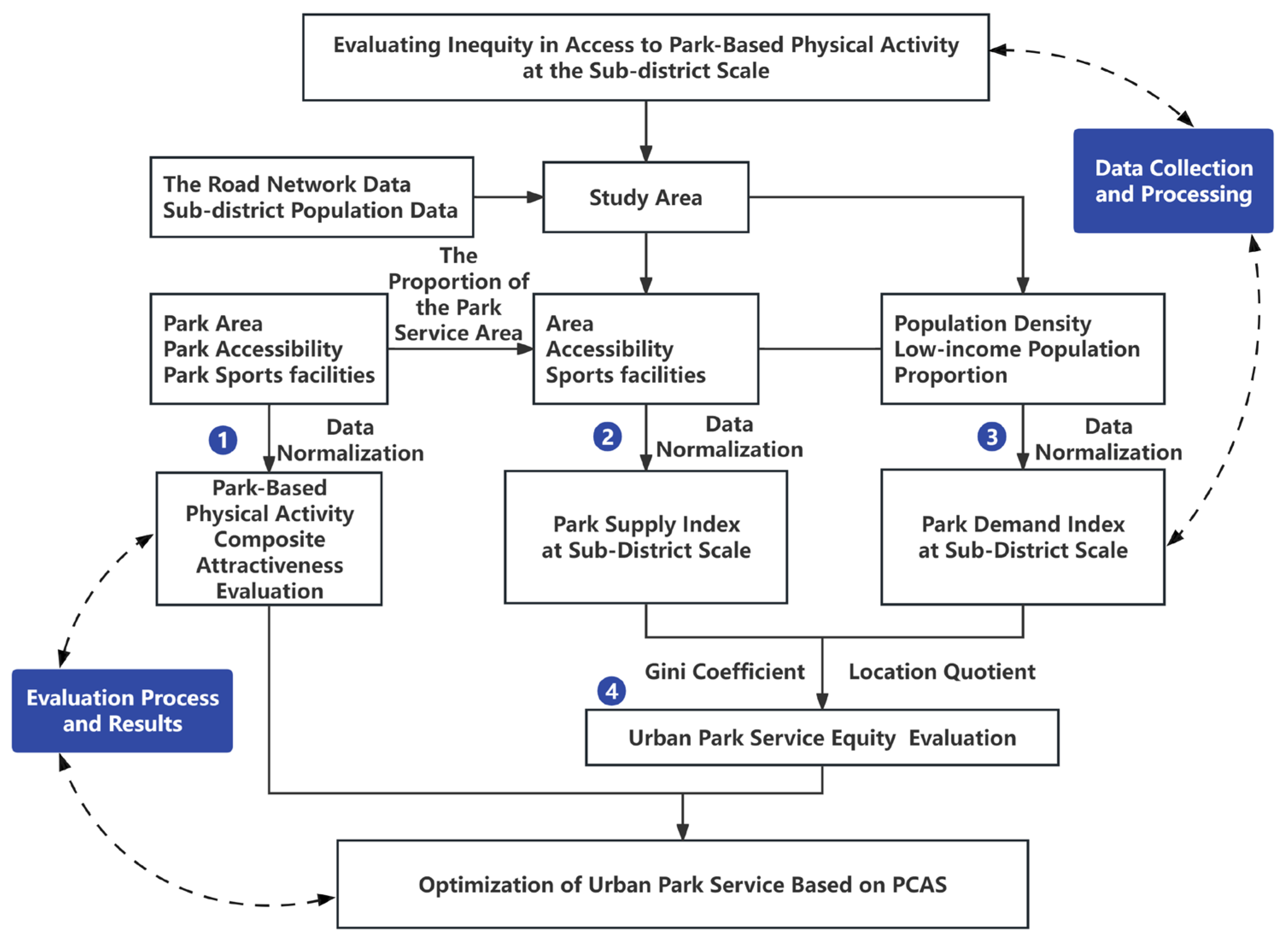
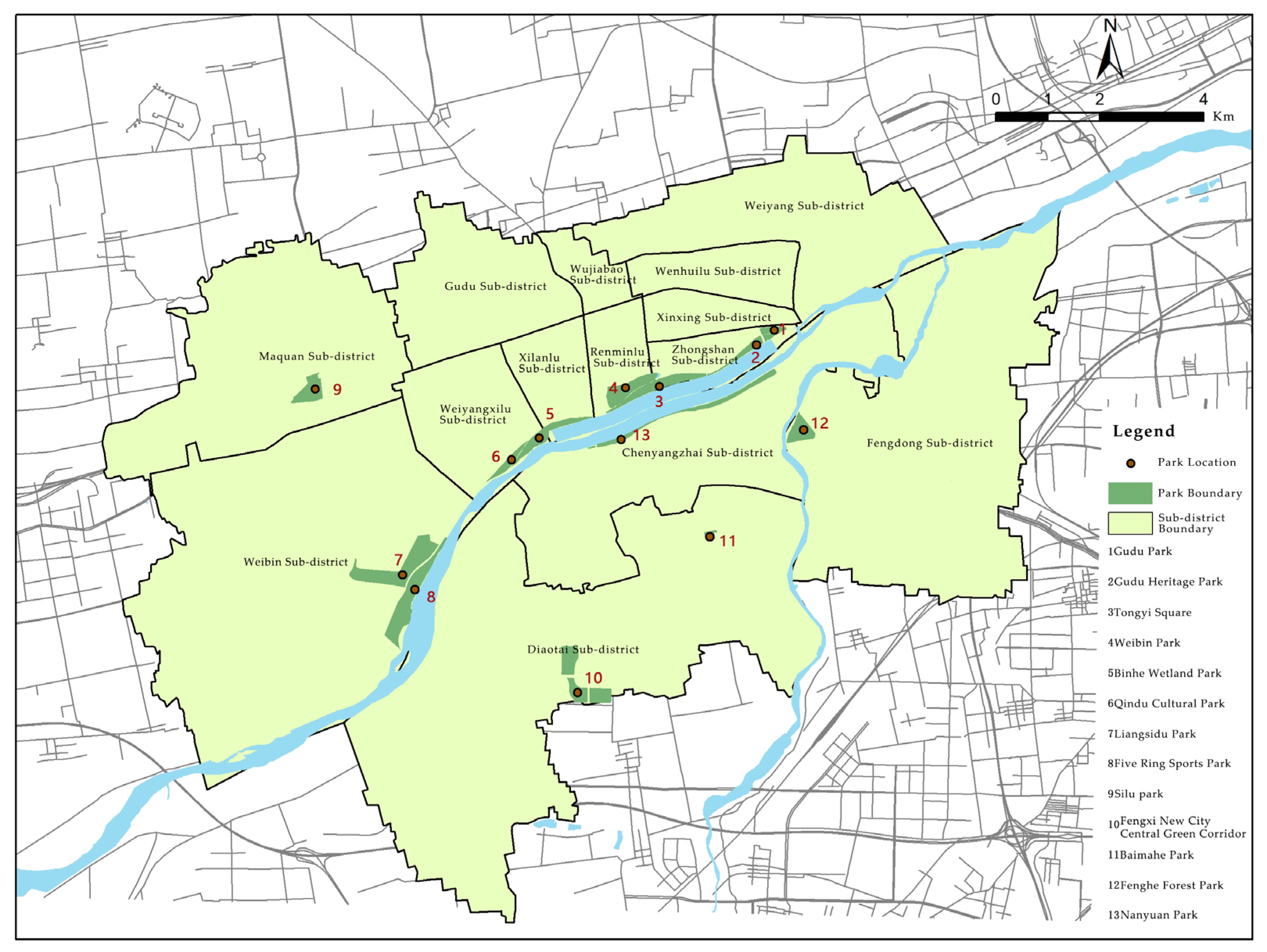
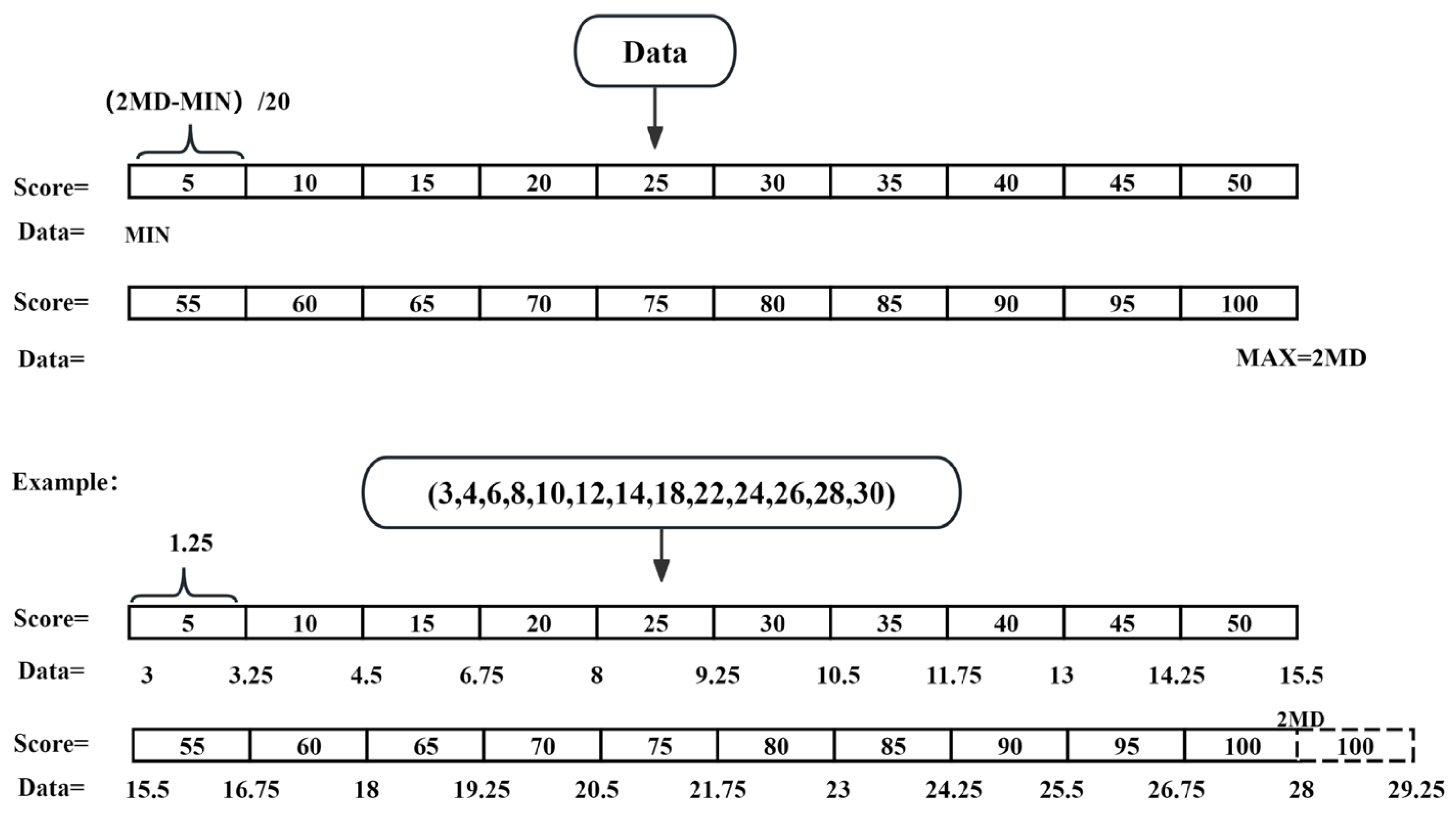

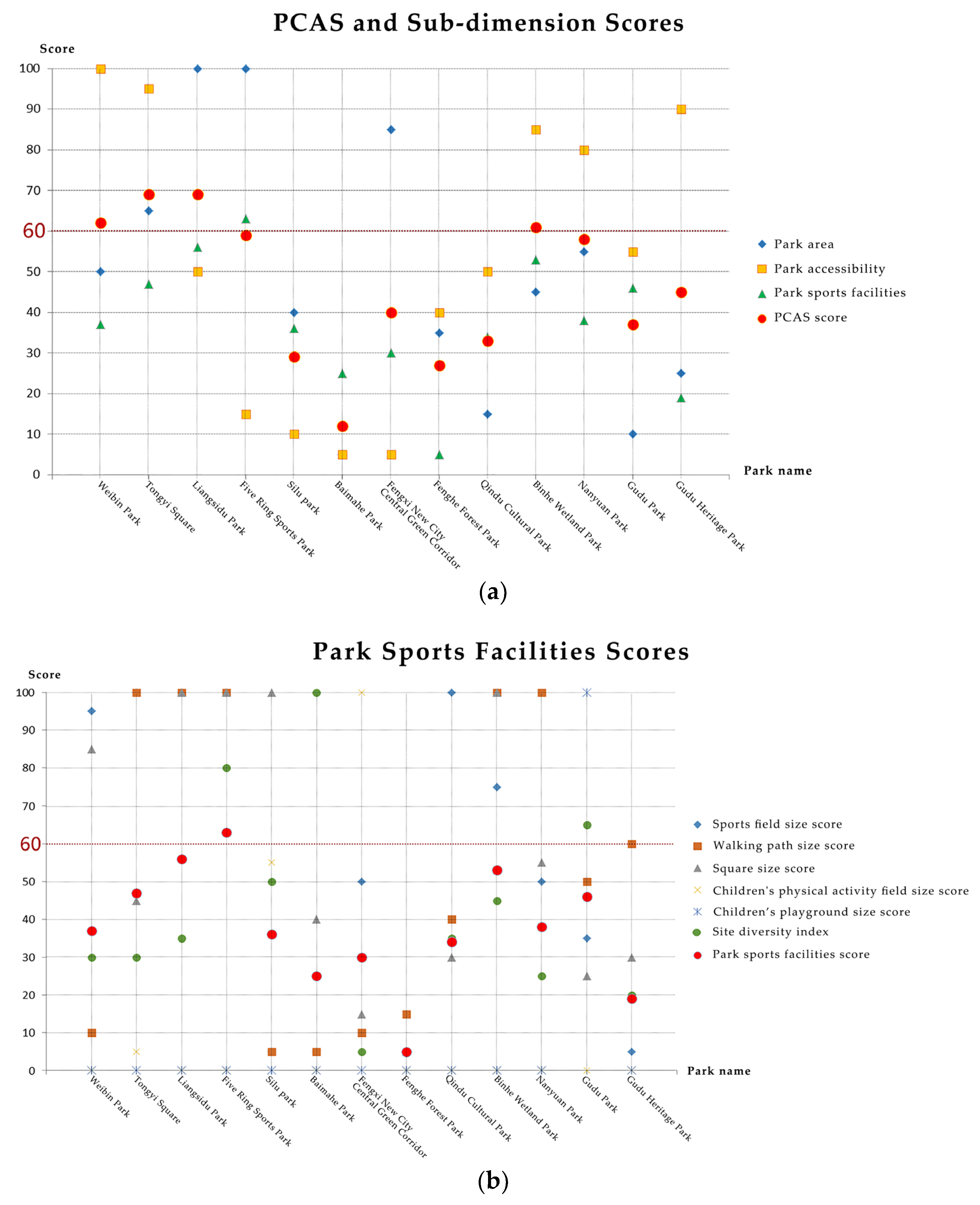
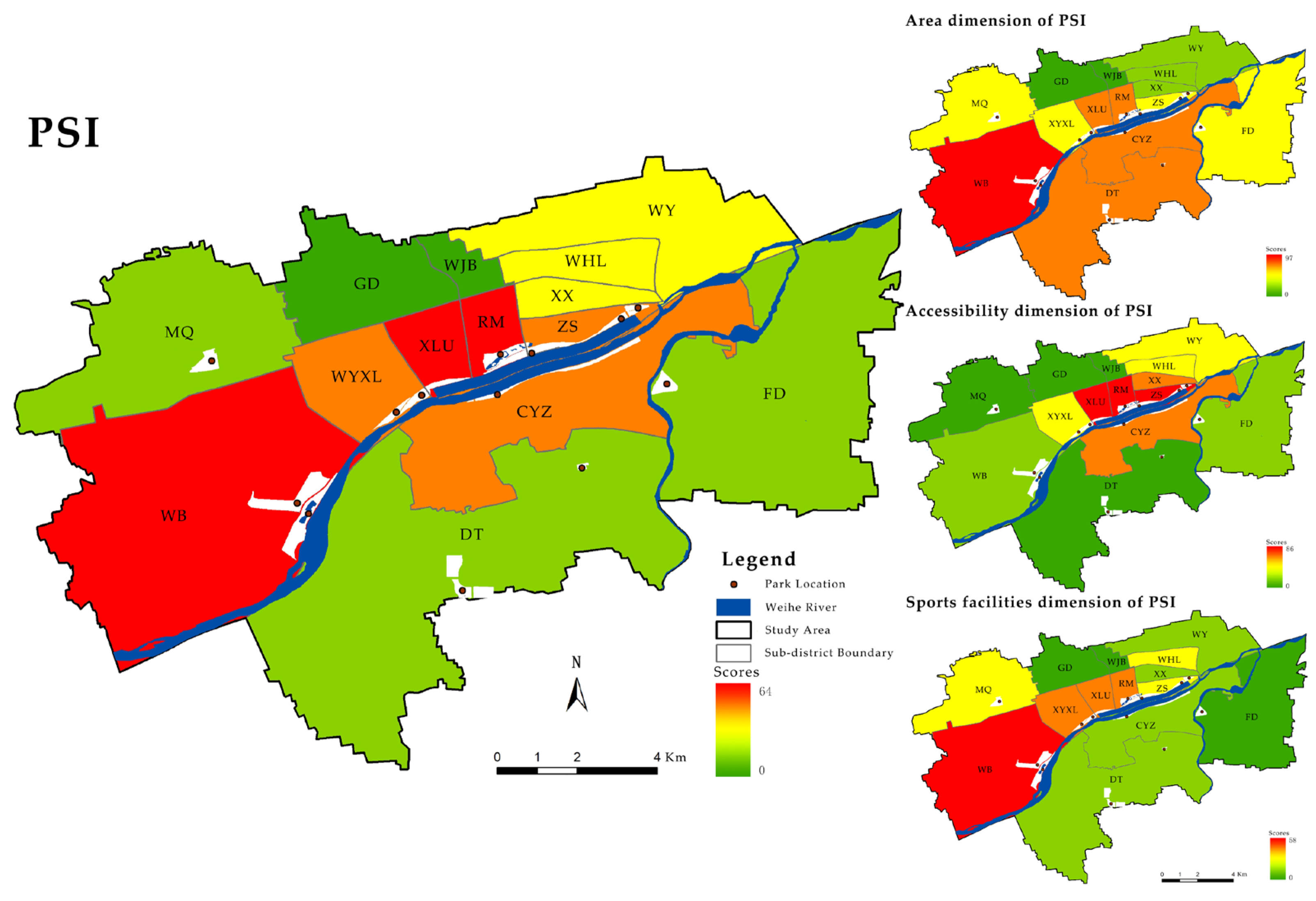
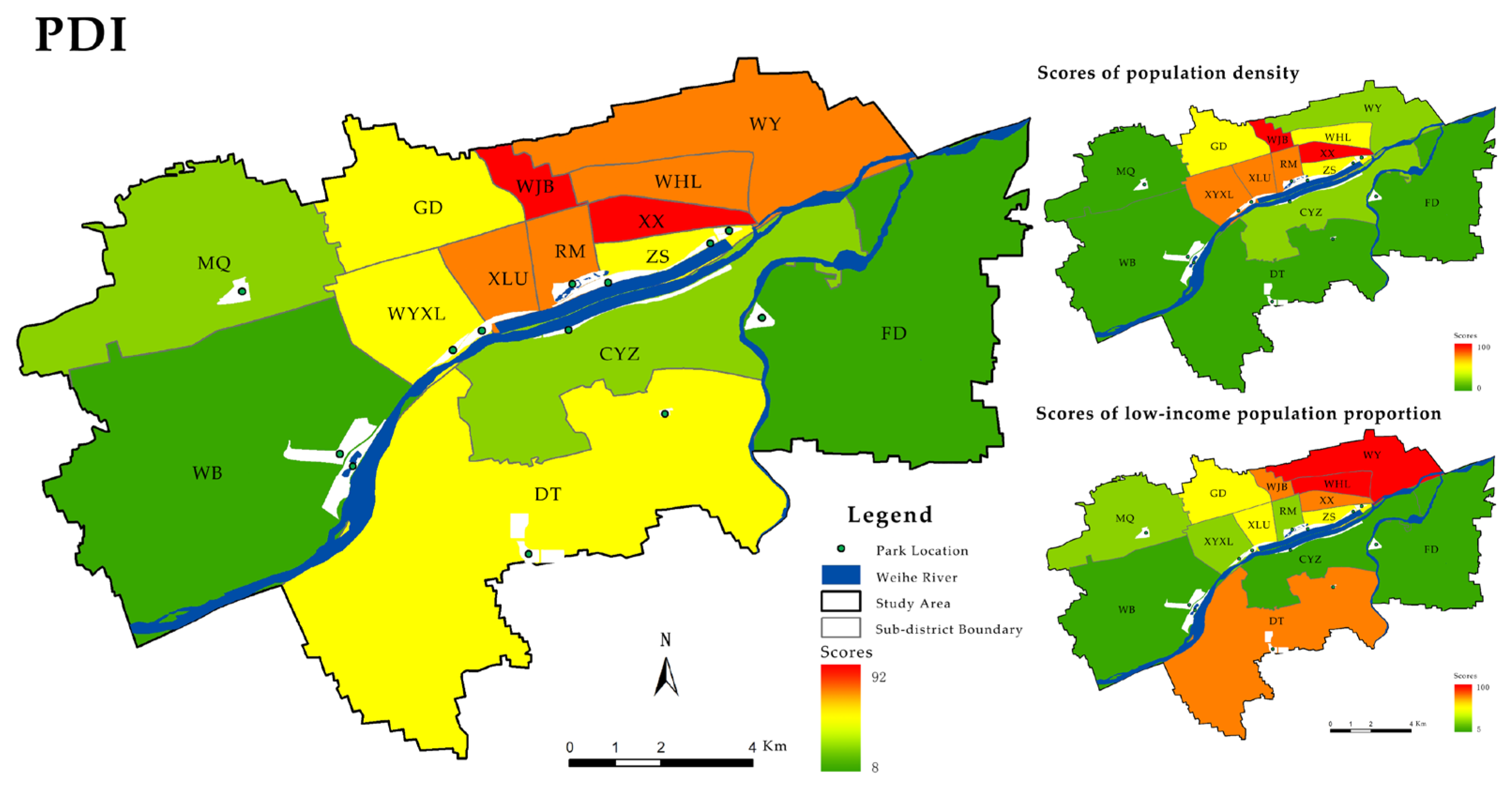
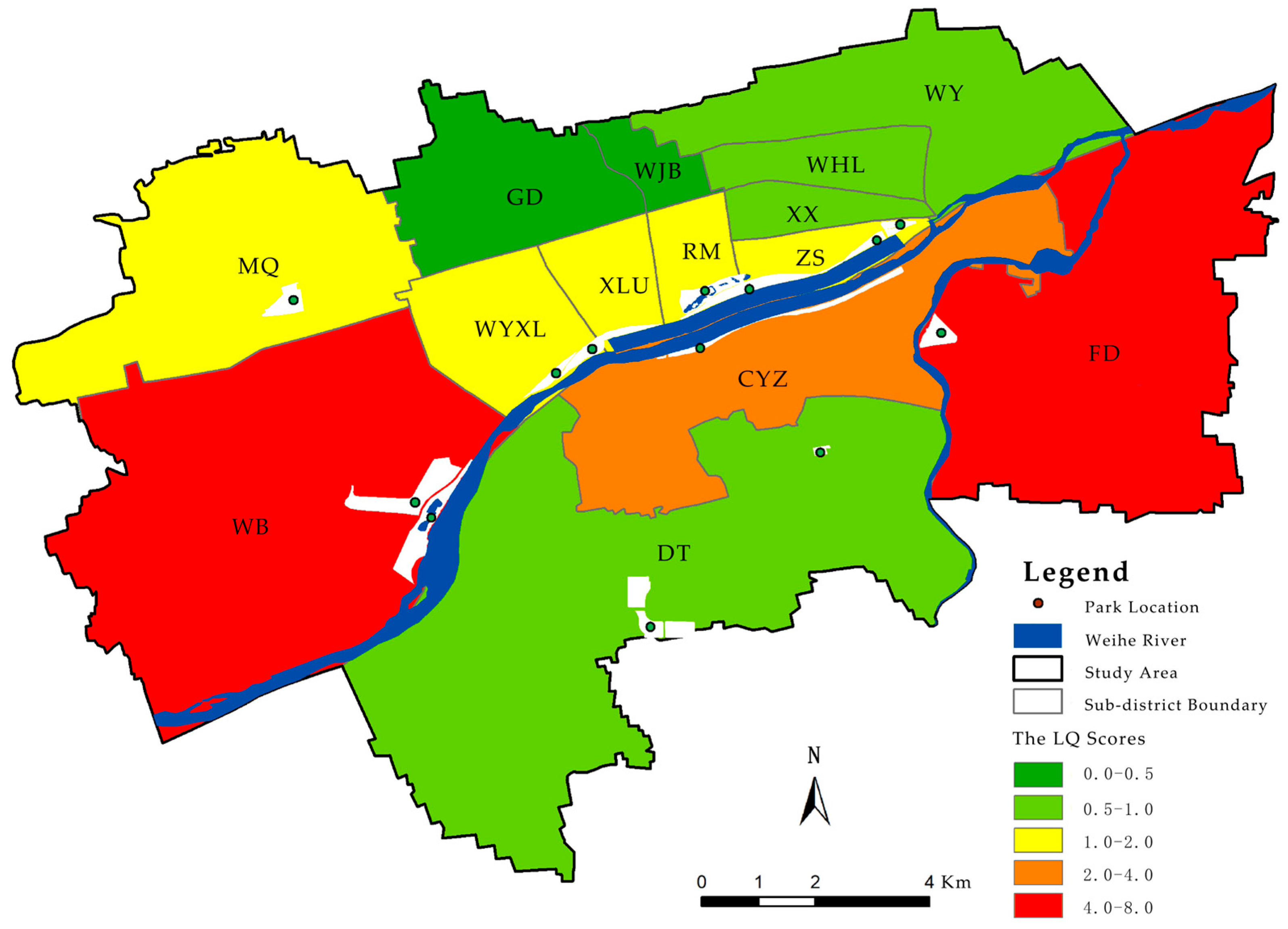

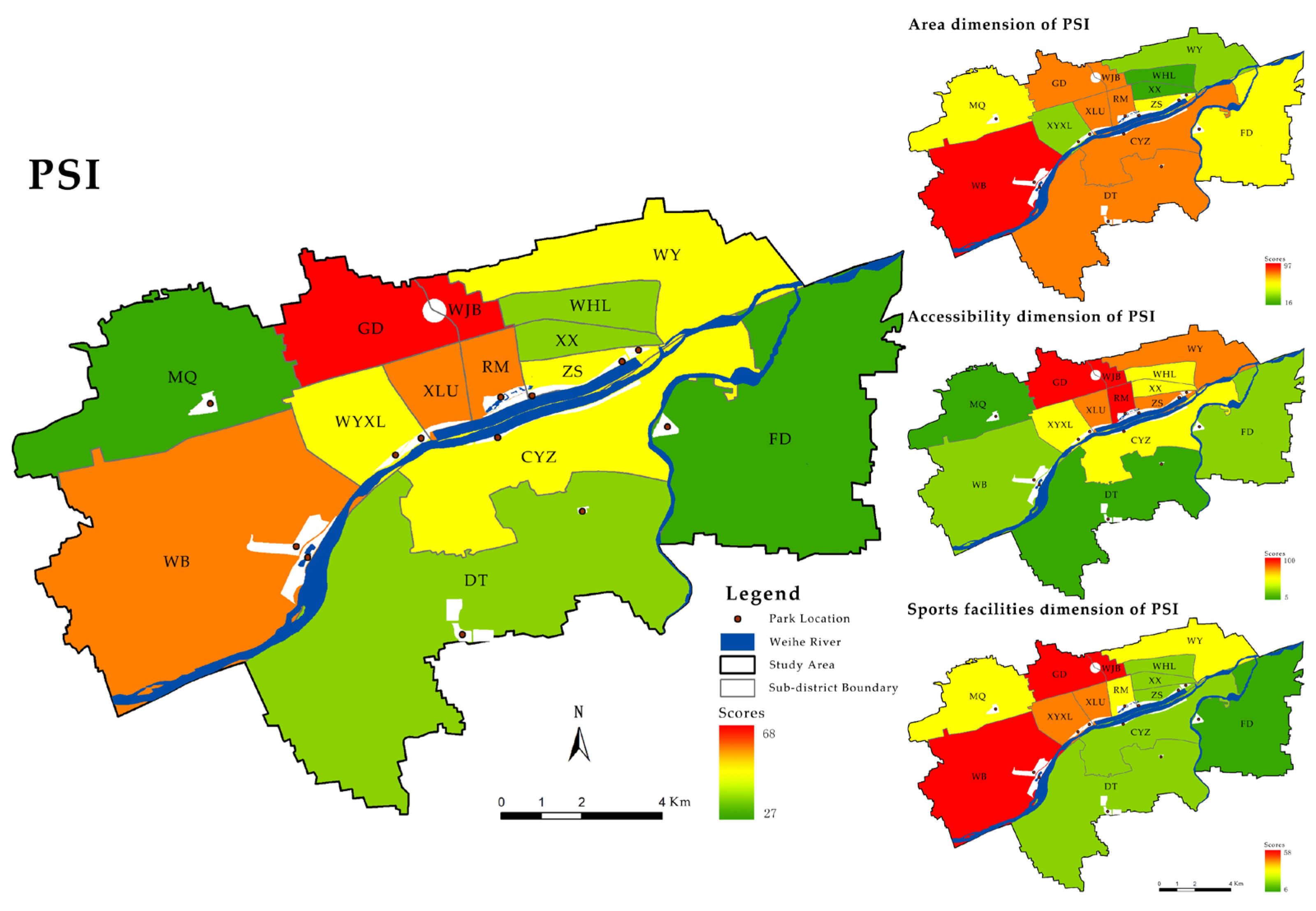
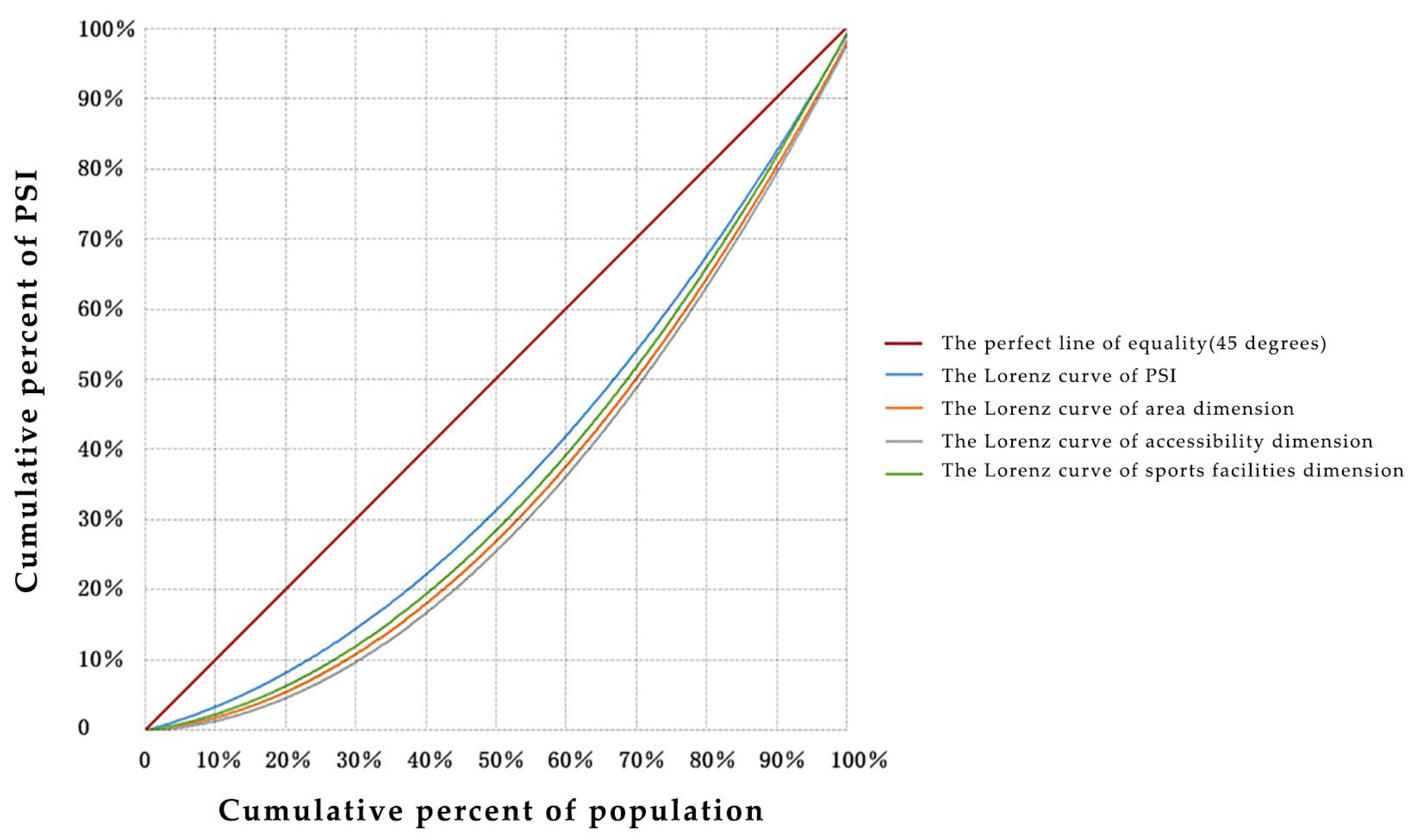

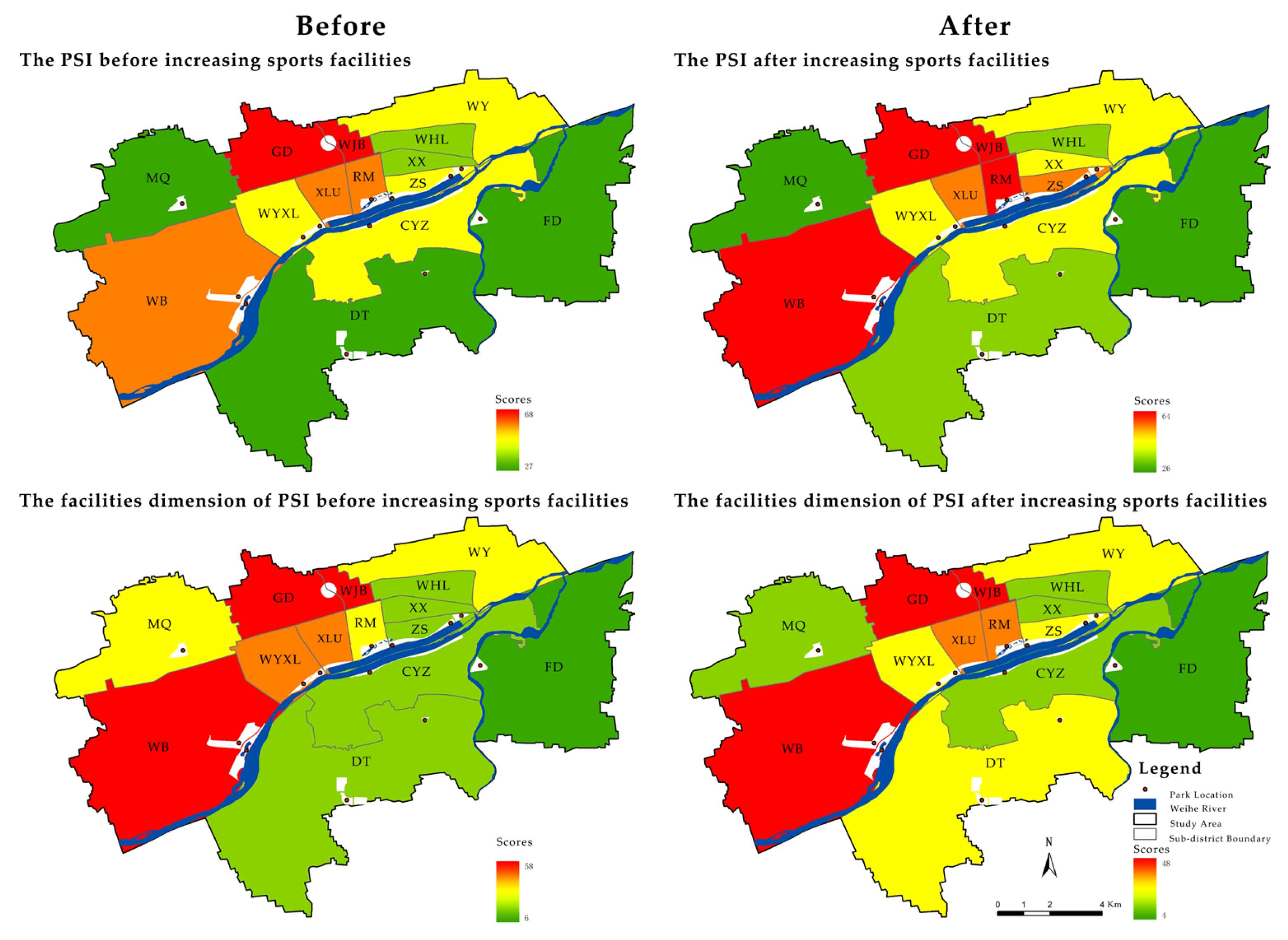
| Park Name | Park Area/ha | Park Classification | Completion Year |
|---|---|---|---|
| Weibin Park | 22.65 | G11 | 1964/2015 |
| Tongyi Square | 29.25 | G13 | 2008 |
| Liangsidu Park | 55.51 | G11 | 2015–2019 |
| Five Ring Sports Park | 47.23 | G13 | 2017 |
| Silu Park | 20.02 | G11 | 2015 |
| Baimahe Park | 3.26 | G12 | 2020 |
| Fengxi New City Central Green Corridor | 39.22 | G13 | 2018 |
| Fenghe Forest Park | 17.98 | G13 | 2014 |
| Qindu Cultural Park | 9.71 | G12 | 2013 |
| Binhe Wetland Park | 22.07 | G13 | 2020 |
| Nanyuan Park | 25.81 | G11 | 2019 |
| Gudu Park | 5.45 | G13 | 1992 |
| Gudu Heritage Park | 12.16 | G13 | 2019 |
| PCAS Sub-Dimension | Item | Method |
|---|---|---|
| Park area | Park size/hm2 | Calculated using ArcGIS 10.7 |
| Park accessibility | Population in the service area/person | A network analysis approach using GIS to calculate street population |
| Park sports facilities | Sports field/m2 | Field measurements |
| Square/m2 | Field measurements | |
| Walking path/m2 | Field measurements | |
| Children’s physical activity field/m2 | Field measurements | |
| Children’s playground/m2 | Field measurements | |
| Site diversity index | Hill numbers index |
| Sub-District Name | Completion Time | Park Name | Number of Park Services |
|---|---|---|---|
| Xilanlu (XLU) | 1980 | Weibin Park | 5 |
| Binhe Wetland Park | |||
| Nanyuan Park | |||
| Qindu Cultural Park | |||
| Tongyi Square | |||
| Renminlu (RM) | 1980 | Weibin Park | 4 |
| Binhe Wetland Park | |||
| Nanyuan Park | |||
| Tongyi Square | |||
| Chenyangzhai (CYZ) | 2001 | Weibin Park | 7 |
| Binhe Wetland Park | |||
| Fenghe Forest Park | |||
| Gudu Heritage Park | |||
| Gudu Park | |||
| Nanyuan Park | |||
| Tongyi Square | |||
| Xinxing (XX) | 1949 | Weibin Park | 5 |
| Gudu Heritage Park | |||
| Gudu Park | |||
| Nanyuan Park | |||
| Tongyi Square | |||
| Zhongshan (ZS) | 1986 | Weibin Park | 5 |
| Gudu Heritage Park | |||
| Gudu Park | |||
| Nanyuan Park | |||
| Tongyi Square | |||
| Diaotai (DT) | 2007 | Baimahe Park | 4 |
| Fengxi New City Central Green Corridor | |||
| Liangsidu Park | |||
| Five Ring Sports Park | |||
| Weiyangxilu (WYXL) | 2001 | Binhe Wetland Park | 2 |
| Qindu Cultural Park | |||
| Fengdong (FD) | Before 2002 | Fenghe Forest Park | 2 |
| Nanyuan Park | |||
| Wenhuilu (WHL) | 1987 | Gudu Heritage Park | 2 |
| Gudu Park | |||
| Weiyang (WY) | 2001 | Gudu Heritage Park | 2 |
| Gudu Park | |||
| Weibin (WB) | Designated as a High-Tech Zone in 2005; Changed from town to sub-district in 2011. | Liangsidu Park | 3 |
| Silu Park | |||
| Five Ring Sports Park | |||
| Maquan (MQ) | 2007 | Silu Park | 1 |
| Gudu (GD) | 2001 | / | 0 |
| Wujiabao (WJB) | 1992 | / | 0 |
| Index | Evaluation | |
|---|---|---|
| Gini Coefficient | <0.2 | Perfect equality |
| 0.2–0.3 | Relative equality | |
| 0.3–0.4 | Adequate equality | |
| 0.4–0.5 | Big equality gap | |
| >0.5 | Severe equality gap |
| Gini Coefficient | Before Optimization | After Optimization | Change |
|---|---|---|---|
| Total of Park Services | 0.38 | 0.3 | −0.08 |
| Area Dimension | 0.47 | 0.39 | −0.08 |
| Accessibility Dimension | 0.48 | 0.38 | −0.1 |
| Sports Facilities Dimension | 0.42 | 0.3 | −0.12 |
| Diaotai Sub-District | Chenyangzhai Sub-District | |||||
|---|---|---|---|---|---|---|
| PSI | Scores in Scenario I | Scores in Scenario II | Trend | Scores in Scenario I | Scores in Scenario II | Trend |
| Total Score | 31 | 29 | ↓ | 50 | 48 | ↓ |
| Area Dimension | 55 | 34 | ↓ | 46 | 43 | ↓ |
| Accessibility Dimension | 7 | 26 | ↑ | 73 | 71 | ↓ |
| Sports Facilities Dimension | 30 | 28 | ↓ | 31 | 30 | ↓ |
| Gini Coefficient | Before Optimization | After Optimization | Change |
|---|---|---|---|
| Total of Park Services | 0.3 | 0.3 | 0 |
| Area Dimension | 0.39 | 0.37 | −0.02 |
| Accessibility Dimension | 0.38 | 0.38 | 0 |
| Sports Facilities Dimension | 0.3 | 0.32 | 0.02 |
Disclaimer/Publisher’s Note: The statements, opinions and data contained in all publications are solely those of the individual author(s) and contributor(s) and not of MDPI and/or the editor(s). MDPI and/or the editor(s) disclaim responsibility for any injury to people or property resulting from any ideas, methods, instructions or products referred to in the content. |
© 2024 by the authors. Licensee MDPI, Basel, Switzerland. This article is an open access article distributed under the terms and conditions of the Creative Commons Attribution (CC BY) license (https://creativecommons.org/licenses/by/4.0/).
Share and Cite
He, M.; Ren, H.; Wang, W.; Feng, X.; Wang, K. Evaluating Inequity in Access to Park-Based Physical Activity at the Sub-District Scale: A Case Study in Xianyang, China. Land 2024, 13, 2179. https://doi.org/10.3390/land13122179
He M, Ren H, Wang W, Feng X, Wang K. Evaluating Inequity in Access to Park-Based Physical Activity at the Sub-District Scale: A Case Study in Xianyang, China. Land. 2024; 13(12):2179. https://doi.org/10.3390/land13122179
Chicago/Turabian StyleHe, Mingyang, Hongqian Ren, Wenxi Wang, Xiaoxiao Feng, and Kai Wang. 2024. "Evaluating Inequity in Access to Park-Based Physical Activity at the Sub-District Scale: A Case Study in Xianyang, China" Land 13, no. 12: 2179. https://doi.org/10.3390/land13122179
APA StyleHe, M., Ren, H., Wang, W., Feng, X., & Wang, K. (2024). Evaluating Inequity in Access to Park-Based Physical Activity at the Sub-District Scale: A Case Study in Xianyang, China. Land, 13(12), 2179. https://doi.org/10.3390/land13122179








